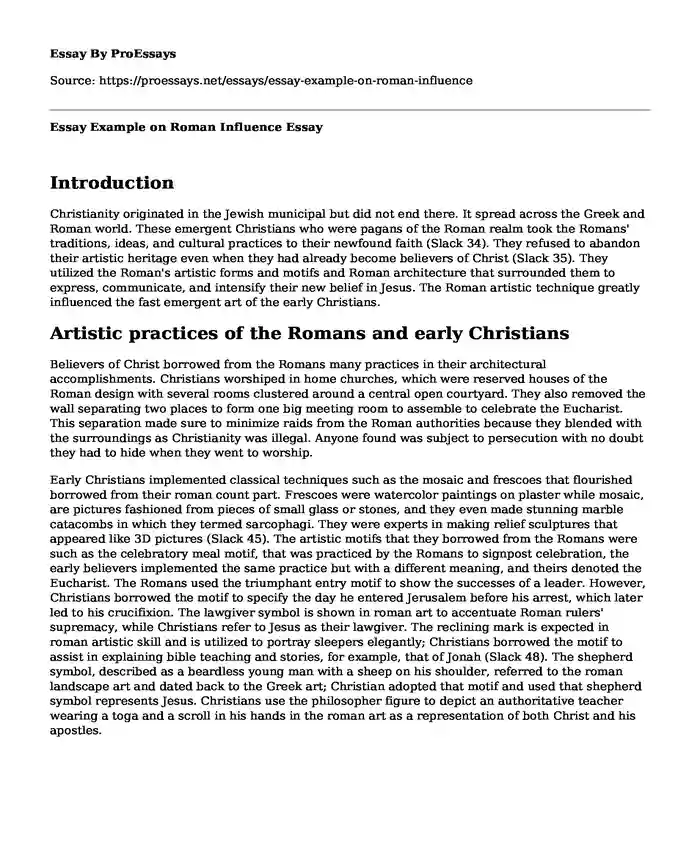Introduction
Christianity originated in the Jewish municipal but did not end there. It spread across the Greek and Roman world. These emergent Christians who were pagans of the Roman realm took the Romans' traditions, ideas, and cultural practices to their newfound faith (Slack 34). They refused to abandon their artistic heritage even when they had already become believers of Christ (Slack 35). They utilized the Roman's artistic forms and motifs and Roman architecture that surrounded them to express, communicate, and intensify their new belief in Jesus. The Roman artistic technique greatly influenced the fast emergent art of the early Christians.
Artistic practices of the Romans and early Christians
Believers of Christ borrowed from the Romans many practices in their architectural accomplishments. Christians worshiped in home churches, which were reserved houses of the Roman design with several rooms clustered around a central open courtyard. They also removed the wall separating two places to form one big meeting room to assemble to celebrate the Eucharist. This separation made sure to minimize raids from the Roman authorities because they blended with the surroundings as Christianity was illegal. Anyone found was subject to persecution with no doubt they had to hide when they went to worship.
Early Christians implemented classical techniques such as the mosaic and frescoes that flourished borrowed from their roman count part. Frescoes were watercolor paintings on plaster while mosaic, are pictures fashioned from pieces of small glass or stones, and they even made stunning marble catacombs in which they termed sarcophagi. They were experts in making relief sculptures that appeared like 3D pictures (Slack 45). The artistic motifs that they borrowed from the Romans were such as the celebratory meal motif, that was practiced by the Romans to signpost celebration, the early believers implemented the same practice but with a different meaning, and theirs denoted the Eucharist. The Romans used the triumphant entry motif to show the successes of a leader. However, Christians borrowed the motif to specify the day he entered Jerusalem before his arrest, which later led to his crucifixion. The lawgiver symbol is shown in roman art to accentuate Roman rulers' supremacy, while Christians refer to Jesus as their lawgiver. The reclining mark is expected in roman artistic skill and is utilized to portray sleepers elegantly; Christians borrowed the motif to assist in explaining bible teaching and stories, for example, that of Jonah (Slack 48). The shepherd symbol, described as a beardless young man with a sheep on his shoulder, referred to the roman landscape art and dated back to the Greek art; Christian adopted that motif and used that shepherd symbol represents Jesus. Christians use the philosopher figure to depict an authoritative teacher wearing a toga and a scroll in his hands in the roman art as a representation of both Christ and his apostles.
Summary
In conclusion, most of the early Christian practices got directly linked to the Romans' artistic skill, this is the life they had known, and art was a big part of the community as they expressed themselves through it, somehow they had to borrow some of the rules and give them a new meaning. The roman empire was against it, for Christianity was an underground religion for the first 300-500 years of its existence. Christianity adopted the artistic skills of the Romans. It changed their meaning entirely as they wanted to nature their newfound faith, be able to communicate and understand each other better, and also be able to teach those new in faith about Jesus. The use of imagery was, therefore, vital to them.
Reference
Donfried, Karl P. Paul, Thessalonica, and Early Christianity. Grand Rapids, Mich: William B. Eerdmans Pub. Co, 2002. Internet resource.
Humphries, Mark. Early Christianity. London: Routledge, 2007. Print.
Klauck, Hans-Josef. The Religious Context of Early Christianity: A Guide to Graeco-Roman Religions. Minneapolis: Fortress Press, 2003. Print.
Slack, S B. Early Christianity. London: Constable, 1914. Internet resource.
Cite this page
Essay Example on Roman Influence. (2024, Jan 06). Retrieved from https://proessays.net/essays/essay-example-on-roman-influence
If you are the original author of this essay and no longer wish to have it published on the ProEssays website, please click below to request its removal:
- Essay Sample on Gilded Age Tycoons
- The Temple of Zeus Essay
- Michael William Masser: Musician Biographical Paper
- How the Children were Affected by World War 1 - Paper Example
- Paper Example on Timeless Literature in Ancient Greece Culture
- Song Analysis Essay on Runaway Train
- Essay Example on 3 Ancient Healing Traditions: Scientific, Heroic & Wise Woman







